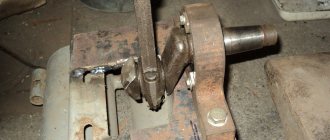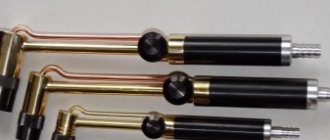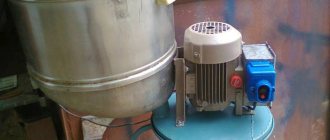If you are in the business of making knives or swords, it is very important for you to be able to melt steel. In this article I will show the drawings and tell you how to make a gas forge with your own hands.
I use propane as fuel. If you work in a rural area, you may find it more economical and convenient to use coal.
Watch the video version.
Let's take the forge
For a novice blacksmith to gain experience and flair, it is best to quickly make a mini-forge from 6 fireclay bricks, see fig. You can’t heat the blade of an ax for shaving or a hunting knife in it for hardening, but you can heat small items for artistic forging, the ends of a long piece for forging or bending, or melt precious colors in a crucible.
The grate shelves are made from scraps of steel pipes, and the grate itself is made from steel strip 4-6 mm thick. The grate bars must be screwed at an angle to capture the air flow, as shown in Fig. Fuel - coke or coal. Ignition and blowing - with a blowtorch, gas or gas-air burner.
This forge is used only outdoors, because... there is no umbrella with a chimney.
Equipment and tools
Any blacksmith's workshop, even a fully mechanized one, must have the main element of the craft - a forge.
After all, it is when heated that steel and iron become soft and plastic, which makes them pliable when processed. The design of a forge is quite simple - in fact, it is a furnace in which fuel burns. But to increase the combustion temperature, additional air supply must be provided. Previously, furs were used for this, which pumped oxygen into the hearth.
The simplest gas mini-forge for small forgings can even be made from a tin can. How this is done is shown in the provided video:
Such a device will allow you to produce forged items even in a garage or shed in the country.
The main condition when operating a forge is that sufficient heating temperature must be provided. It is best to have a solid fuel fireplace that burns coal. Also a good option is a gas forge.
It is important to take care of a high-quality hood that will remove fuel combustion products!
The second device for a forge is the presence of an anvil. This is the “worktable” of any blacksmith. Anvils come in various sizes and dimensions.
But for full-fledged forging, additional holes in the surface and the ability to attach additional equipment (for example, crimpers and smoothers) will be required. Also, for bending elements, there is a rounded horn on the anvil. It is used as a kind of mandrel. However, a homemade anvil made from a massive piece of metal, such as a rail, will also work.
After this, you need to take care and purchase a blacksmith tool.
- Handbrake.
- Sledgehammers.
- Ticks.
- Vise.
- Crimpers and ironers.
- Chisels.
- Collars.
Handbrake hammers are small hammers with which the master does the main work. Their weight ranges from 500 grams to two kilograms. The hammer itself is mounted on a wooden handle, usually made of rowan (smoothes out the recoil upon impact).
The sledgehammer is intended for rough work, for example, crimping large and massive workpieces. Its weight is 2-8 kilograms, the handle, like the handbrake, is wooden.
Pliers are needed to manipulate heated metal elements during forging. They must be long enough and also durable. The grip must be strong so that the part does not slip out with every blow and movement.
A vice, or a metalworker's vice, may be suitable. Quite often, a vice is mounted on an anvil for more convenient work. The main thing is that they provide reliable fastening of parts during forging.
Crimpers and ironers are special devices that are mounted on an anvil during hand forging. Their task is akin to a factory stamp - to give the desired shape to the workpiece and smooth out its front parts.
They use wrenches when it is necessary to twist metal parts, and chisels are used to cut metal. Also, for cold working, you can mount a manual machine, where it will be more convenient to twist and bend the metal.
However, in a modern workshop, chopping is completely replaced by cutting using a grinder. The same applies to various punches. They can easily be replaced with a drilling workbench or even an electric drill.
However, even the presence of a simple device can easily replace electric forging machines with your own hands.
If you plan to engage in forging at a more serious level, then you will need the appropriate equipment.
Making a stove from a blowtorch
When making a forge for forging with your own hands, the blowtorch must be installed in a recess, around the perimeter of which fireclay bricks with a grate must be laid. When laying refractory bricks, it is necessary to maintain the distance between the enclosing elements in order to ensure the flow of air masses into the combustion chamber. The angle of location of the blocks of building material relative to each other is determined by the master.
Charcoal or coke is poured into a recess made of bricks on a grate, and a pipe is put on the blowtorch, which is fed under the grate. The blank for forging is placed in the gap between the brickwork, and the coal concentrate is ignited from below. To remove smoke, a probe, tent or chimney is installed above the grate.
Conclusions and useful video on the topic
A few secrets to improve the performance of the forge:
- The back wall with a cutout will improve ventilation and make it possible to work with long workpieces.
- A metal stand for the forge will make work more convenient.
- To work with workpieces of different sizes, it is more convenient to use several forges of different sizes standing next to each other. Air is supplied using flexible hoses for quick switching between burners.
- Each “main” must have shut-off valves. For smooth adjustment, ball valves should be abandoned.
Having at hand a small supply of tools, a gas burner diagram and the necessary materials, every home craftsman can assemble a propane burner. It is important to follow fire safety rules and use only high-quality materials approved for use in the domestic gas supply system. But if you are not confident in your own abilities, it is better to purchase such a device in a store.
If you had to assemble a propane burner yourself, please share your knowledge with our readers and tell us which option you chose. Why was he chosen and were there any difficulties during the work process? Perhaps you have a diagram of the device and a photo of the finished homemade product - include visual information in the discussion of the material.
Video on the topic
In this article we will look at how to make a gas torch for soldering with your own hands. This device is often in demand both in private households and for commercial purposes - for individual technical creativity and various types of construction tasks. In particular, gas burners are used for soldering, metalsmithing, forging, roofing, jewelry work, and for other purposes they produce flames whose temperature exceeds 1500°C.
In metalworking, using a gas torch, you can heat a metal workpiece so that in the end it turns out to be sufficiently hardened. When carrying out welding work with some metals, the areas of future seams must be heated.
Home gas forge
To make a simple home gas forge, you can use parts from an old bicycle. If you turn the sprocket from the gearbox on a lathe, the device can operate on butane or propane and heat closed furnaces of small volume. An important condition for using a portable design is to prohibit the operation of the burner with acetylene, since the high temperature of the flame can burn the former “star” and the stove will simply explode.
Assembling such a device is not difficult, and a homemade forge for forge is not much inferior to industrial ones, but is much cheaper. The main thing is to follow safety rules during manufacture and use.
Types of gas burners
In order for a home-made gas burner for a forge to ensure the flawless operation of your home forge, you need to know what types of devices are used in such designs. There are only a few of them:
- Reliable and very simple in design sting jet torches. In them, gas moves along the central axis, and the air flow moves tangentially to the mixer. This approach leads to significant pressure losses. In addition, the air has a greater effect on the area of metal being processed, which is why scale appears on its surface.
- Injection devices. As the name suggests, they use an injector that ensures self-suction of gas. You can make such a burner with your own hands, but to use it you need to have certain skills.
- Vortex devices. They are very economical, and the design of these devices minimizes pressure loss. The main disadvantage is the very complex design, which makes it impossible to make a burner with your own hands.
- Combined devices that combine pin-jet and direct-flow principles of operation. Advantages: the ability to regulate the supply of a mixture of gas and air, as well as effective control of the heating temperature of the metal workpiece. Disadvantages are large dimensions, which do not allow the burner to be used for a compact forge in a home forge, as well as a complex design.
So, the simplest solution for creating a device with your own hands is a sting torch. When starting to manufacture it, remember that it should provide:
- flawless operation even with increasing humidity levels in the internal cavity of the forge;
- safe combustion of the gas-air mixture;
- a stable flame that can evenly heat a metal workpiece;
- protection against so-called kickback; it occurs when there is an unexpected change in the direction of thrust; As a result, the mixture in the forge explodes, which can cause serious injury or even death;
- increased speed of the gas jet with increased width and low height.
Making a forge for your own forge
Hand forging is becoming increasingly popular - both to meet your own needs and to produce various products to order. Heating of metal, in order to increase its plastic characteristics, must be performed in special heating devices, the simplest of which is a forge. The main task of the forge is to ensure a stable increase in the temperature of the metal to forging temperatures, i.e., no less than 1200 °C. How to make a homemade forge, and whether it is possible in principle, is discussed below.
Purpose of the forge parts
Now let's go back to the list at the beginning and see what's in the forge for what. And then we’ll get down to making the forge using the samples discussed below or independently, based on the available materials and capabilities.
In industry, tables are mostly lined with quartz refractory brick; it lasts for decades under intense workload. A homemade furnace is usually lined with fireclay bricks, which are cheaper and more accessible. With irregular use, it will also last for years.
A firebox with a grate, an air chamber with drainage and a supply pipe with a valve form the heart of the forge - the tuyere. In industrial designs, replaceable lances are used for different heating methods and heated workpieces. For an amateur or individual craftsman, most often it is enough to have one grate tightly mounted into the table with a solid grate perforated with round holes.
Air drainage is necessary to accurately and quickly regulate the blast without taking your eyes off the workpiece. It will not be possible to forge an underheated part and it will not accept hardening; overheated and overdried, it will tear under a hammer, and in a quenching bath it will at least fail, or even crack. And in any case it will turn out to be unacceptably fragile. How to determine its readiness for forging or hardening by the appearance of a red-hot workpiece is a separate matter. But experienced blacksmiths know that they need to be able to release excess air into the atmosphere in seconds.
The purpose of the chamber, or tent, of the forge, together with its umbrella and chimney, is to remove flue gases from the working area. There are plenty of them released during the preparation of the coal mass (see below), and none of them are good for health. The draft in the chimney needs to be good, because... The front (working) window of the tent and openings for lengthy items (pipes, metal profiles) are constantly open.
As for the quenching bath and gas-air chamber, they may or may not be there, it’s at your discretion. A hardening bath is definitely needed if you are going to forge the so-called. Damascus, damask steel products. They need thermal shock hardening, i.e. from the forge - instantly into the bath.
The gas-air chamber is used in industry:
- For additional drying and heating of air.
- To clean blast air from impurities and condensate.
- For introducing gaseous alloying additives into the air.
At home, super-super special spas are not obtained; The problem of condensation in production occurs when blowing from a common compressed air network. In a low-power furnace, the air heats up sufficiently when passing through the holes of the lance grate, and household gas can be purified from sulfur by passing it through a layer of naphthalene, as mentioned above. In general, make a gas vent, don’t do it, it’s up to you.
Finally, the crucible. This is a heat-resistant cap that expands the extremely high temperature zone. It is installed if non-ferrous or precious metals and alloys are melted in a crucible in a furnace (melting point of gold is 1060 degrees, silver is 960, copper is 1080, brass and bronze is 900), parts are cemented in a muffle, etc. There is no point in looking for an expensive ready-made crucible; in a home forge, it can be completely replaced by a dozen fireclay bricks laid out on a dry surface, piece by piece. In this configuration, a homemade forge will replace an expensive muffle furnace.











